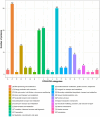Comprehensive analysis of the succinylome in Vero cells infected with peste des petits ruminants virus Nigeria 75/1 vaccine strain
- PMID: 39885502
- PMCID: PMC11784008
- DOI: 10.1186/s12917-025-04496-3
Comprehensive analysis of the succinylome in Vero cells infected with peste des petits ruminants virus Nigeria 75/1 vaccine strain
Abstract
Background: Peste des petits ruminants virus (PPRV) is currently the only member of the Morbillivirus caprinae species within the genus Morbillivirus of the family Paramyoxviridae. PPRV causes a highly contagious disease in small ruminants, especially goats and sheep. Succinylation is a newly identified and conserved modification and plays an important role in host cell response to pathogen infection. However, the extent and function of succinylation in Vero cells during PPRV infection remains unknown.
Results: In this study, a global profile of the succinylome in Vero cells infected with PPRV Nigeria 75/1 vaccine strain (PPRVvac) was performed by dimethylation labeling-based quantitative proteomics analysis. A total of 2633 succinylation sites derived from 823 proteins were quantified. The comparative analysis of differentially succinylated sites revealed that 228 down-regulated succinylation sites on 139 proteins and 44 up-regulated succinylation sites on 38 proteins were significantly modified in response to PPRVvac infection, seven succinylation motifs were identified. GO classification indicated that the differentially succinylated proteins (DSuPs) mainly participated in cellular respiration, biosynthetic process and transmembrane transporter activity. KEGG pathway analysis indicated that DSuPs were related to protein processing in the endoplasmic reticulum. Protein-protein interaction networks of the identified proteins provided further evidence that various ATP synthase subunits and carbon metabolism were modulated by succinylation, while the overlapped proteins between succinylation and acetylation are involved in glyoxylate and dicarboxylate metabolism.
Conclusions: The findings of the present study provide the first report of the succinylome in Vero cells infected with PPRVvac and provided a foundation for investigating the role of succinylation alone and its overlap with acetylation in response to PPRVvac.
Keywords: Peste Des petits ruminants virus; Post-translational modification; Protein-protein interaction; Succinylation.
© 2025. The Author(s).
Conflict of interest statement
Declarations. Ethical approval and consent to participate: Not applicable. Consent for publication: Not applicable. Competing interests: The authors declare no competing interests.
Figures








Similar articles
-
Quantitative analysis of acetylation in peste des petits ruminants virus-infected Vero cells.Virol J. 2023 Oct 10;20(1):227. doi: 10.1186/s12985-023-02200-1. Virol J. 2023. PMID: 37817180 Free PMC article.
-
Productive replication of peste des petits ruminants virus Nigeria 75/1 vaccine strain in vero cells correlates with inefficiency of maturation of the viral fusion protein.Virus Res. 2019 Aug;269:197634. doi: 10.1016/j.virusres.2019.05.012. Epub 2019 May 23. Virus Res. 2019. PMID: 31129173
-
The large protein 'L' of Peste-des-petits-ruminants virus exhibits RNA triphosphatase activity, the first enzyme in mRNA capping pathway.Virus Genes. 2019 Feb;55(1):68-75. doi: 10.1007/s11262-018-1617-5. Epub 2018 Dec 3. Virus Genes. 2019. PMID: 30511208 Free PMC article.
-
Peste des petits ruminants virus infection of small ruminants: a comprehensive review.Viruses. 2014 Jun 6;6(6):2287-327. doi: 10.3390/v6062287. Viruses. 2014. PMID: 24915458 Free PMC article. Review.
-
Control of peste des petits ruminants: classical and new generation vaccines.Dev Biol (Basel). 2003;114:113-9. Dev Biol (Basel). 2003. PMID: 14677682 Review.
References
MeSH terms
Substances
Grants and funding
LinkOut - more resources
Full Text Sources

